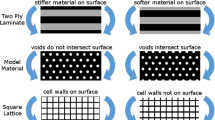Abstract
The size of the struts in nanoporous cellular solids typically has a secondary influence on the stiffness of the solids, but it leads to significant stiffening when it is on the same order as the higher-order material parameter. We examined this size-dependence using the higher-order finite-element method (FEM) in this study. Mathematical analysis showed that the displacement field that satisfies the conventional Lame equation can serve as a displacement field template in higher-order FEM. Benchmarking studies showed that results from simulations of beam bending and rod torsion using this FEM approach were in good agreement with results from analytical solutions and experiments. Using this approach, we showed that the stiffness of cellular solids is strongly affected by the cellular arrangement and the density when the cell size is on the order of the higher-order material parameter and that the stiffening behavior in nanoporous polyimide can be explained using higher-order theory. The FEM results also showed that a porous solid with half the weight can be engineered to become as stiff as a fully dense solid if the porous microarchitecture is tailored to take advantage of higher-order stiffening.



Similar content being viewed by others
References
Ashby MF (2000) Metal foams: a design guide. Butterworth-Heinemann, Boston
Gibson LJ, Ashby MF (1982) Proc R Soc Lond 382:43
Andrews EW, Gioux G, Onck P, Gibson LJ (2001) Int J Mech Sci 43:701
Han SH, Do JS, Kader MA, Lee JH, Lee MH, Nah CW (2004) Polym Adv Technol 15:370
Takeichi T, Zuo M, Ito A (1999) High Perform Polym 11:1
Tekoglu C, Onck PR (2005) J Mater Sci 40:5911. doi:https://doi.org/10.1007/s10853-005-5042-5
Lam DCC, Chong ACM, Yang F, Wang J, Tong P (2003) J Mech Phys Solids 51:1477
McFarland AW, Colton JS (2005) J Micromech Microeng 15:1060
Fleck NA, Muller GM, Ashby MF, Hutchinson JW (1994) Acta Metall Mater 42:475
Lam DCC, Chong ACM (1999) J Mater Res 14:3784
Ma O, Clarke DR (1995) J Mater Res 10:853
Nix WD (1989) Metall Trans A 20:2217
Poole WJ, Ashby MF, Fleck NA (1996) Scr Mater 34:559
Stolken JS, Evans AG (1998) Acta Metall Mater 46:5109
Ashby MF (1970) Philos Mag 21:399
Chong ACM, Yang F, Lam DCC, Tong P (2001) J Mater Res 14:1052
Lam DCC, Keung LH, Tong P (2008) J Mater Sci Eng A (submitted)
Cermal EA (1976) Continuum physics. Academic Press, New York
Fleck NA, Hutchinson JW (1993) J Mech Phys Solids 41:1825
Fleck NA, Hutchinson JW (1997) Adv Appl Mech 33:295
Toupin RA (1962) Arch Ration Mech Anal 11:385
Koiter WT (1964) Proc K Ned Akad Wet (B) 67:17
Mindlin RD (1964) Arch Ration Mech Anal 16:51
Mindlin RD (1965) Int J Solids Struct 1:417
Yang F, Chong ACM, Lam DCC, Tong P (2002) Int J Solids Struct 39:2731
Acknowledgement
Jun Wang acknowledges support from the Shanghai Leading Academic Discipline Project (Project Number: B113). DCC Lam acknowledges funding support (615007, 615505, HKUST6190/03E) from the Research Grants Council of the HKSAR, China.
Author information
Authors and Affiliations
Corresponding author
Appendix I: FEM verification
Appendix I: FEM verification
Higher-order strain gradient solutions are available for torsion, pure bending, and cantilever bending. A two-dimensional eight-node high-order element was used to model the higher-order deformation behavior in cantilever bending and pure bending. A three-dimensional 20-node high-order element was used in the torsion case.
Bending of micro-beams
Pure bending and cantilever bending cases are sketched in Fig. 4. For the pure bending case with small deformation, an analytical solution was developed [22]. The ratio of the total moment to the conventional moment in pure bending of a beam with elasticity is
In the absence of higher-order effects, M reverts to the conventional M0. A comparison of the moment ratio between FEM and the analytical solution in Eq. 29 is shown in Fig. 5.
The bending rigidities for beams with different thicknesses are plotted in Fig. 6. These results show that the FEM results for pure bending and for cantilever bending, where there is shear, are in good agreement with experimentally benchmarked analytical models.
Comparison of the normalized rigidity from experiments [7] and FEM results
Torsion
The behavior of micro-rod torsion was also examined and its typical mesh is illustrated in Fig. 7. The solution for a couple stress solid rod under torsion was derived in [25] and is given as
where Q and Q0 are the couple stress torque and conventional torque, respectively, and r is the radius of the micro-rod. The FEM results are consistent with the analytical solution according to Fig. 8.
Rights and permissions
About this article
Cite this article
Wang, J., Lam, D.C.C. Model and analysis of size-stiffening in nanoporous cellular solids. J Mater Sci 44, 985–991 (2009). https://doi.org/10.1007/s10853-008-3219-4
Received:
Accepted:
Published:
Issue Date:
DOI: https://doi.org/10.1007/s10853-008-3219-4









